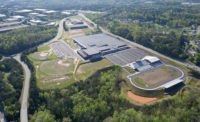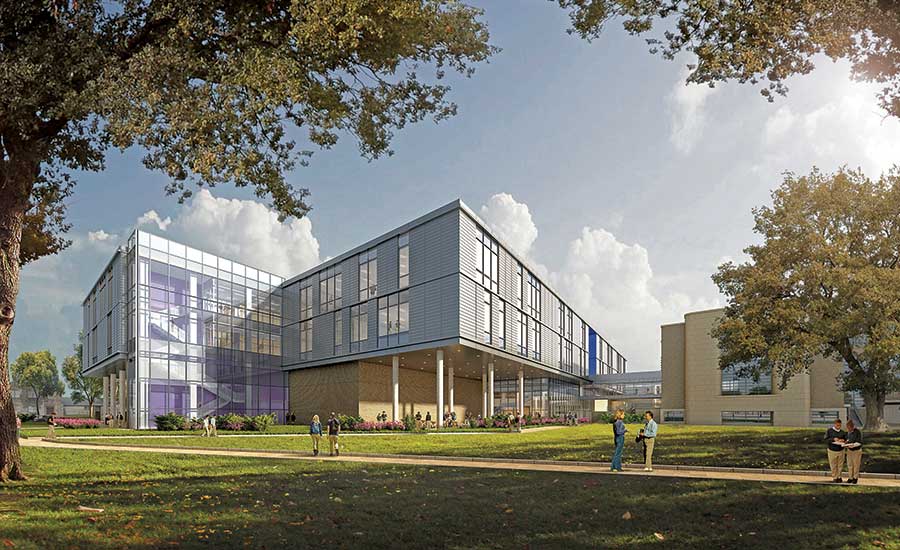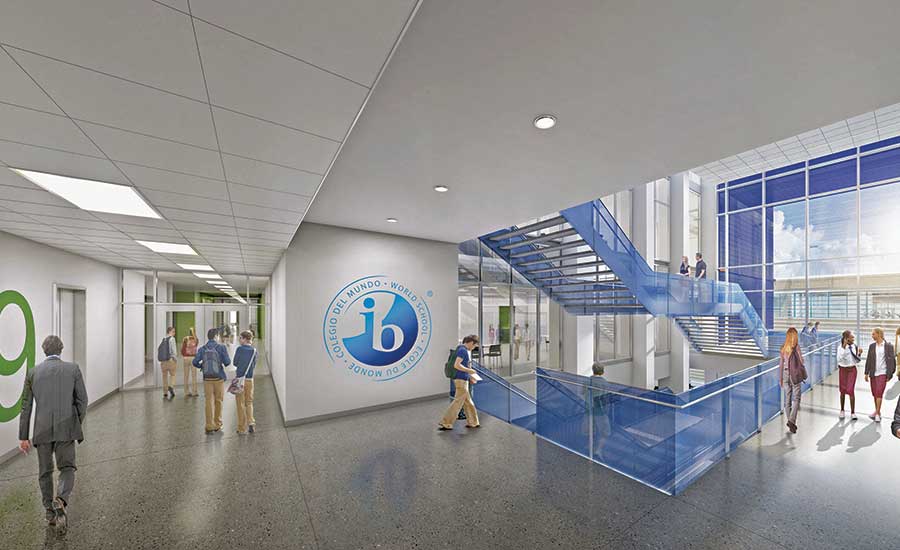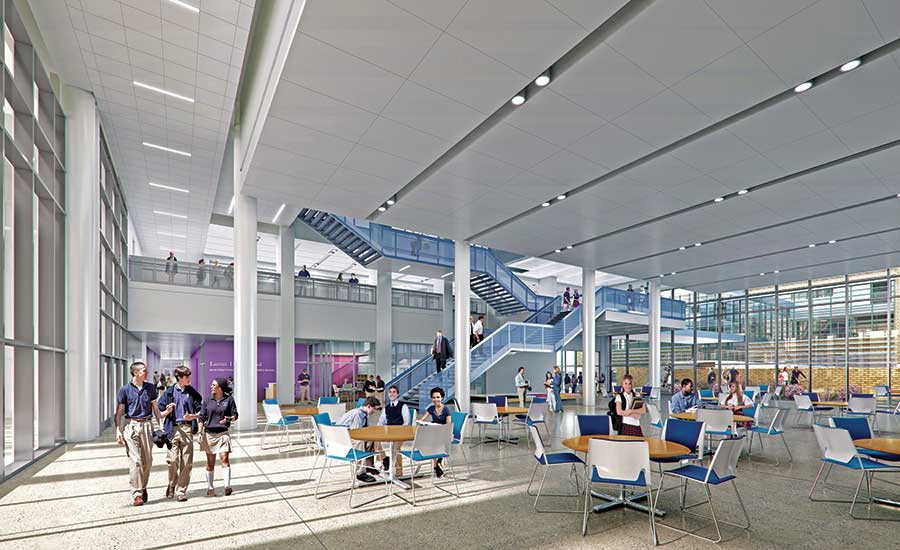Bringing Lamar High School Into the Future

Lamar High School’s new four-story academic wing (shown left) stands alongside the existing building (far right).
RENDERING COURTESY OF PERKINS+WILL

Lamar’s new design features 16 smaller learning communities, called neighborhoods.
RENDERING COURTESY OF PERKINS+WILL

An entry section perspective of the new academic wing and its connection to the existing building.
IMAGE COURTESY PERKINS+WILL

A rendering shows the vision for Lamar’s new natatorium.
IMAGE COURTESY PERKINS+WILL

Also pictured is the interior of the natatorium following placement of 550 cu yd of concrete for the pool shell by Paddock Southwest.
IMAGE COURTESY GILBANE BUILDING CO.

Lamar’s main kitchen area, where meals will be prepared and then delivered to the 16 neighborhood spaces.
PHOTO COURTESY OF GILBANE BUILDING CO.

A rendering of what the new campus lobby will look like.
RENDERING COURTESY OF PERKINS+WILL







A vision for a 21st-century school is becoming reality with the renovation and expansion underway at Houston Independent School District’s Lamar High School.
Fueled by a $1.89-billion bond package passed by Houston voters in 2012, which will fund the rebuilding or renovation of 40 HISD schools, the Lamar High School project broke ground in March 2017 after nearly five years of planning.
Before design began, the project team understood that Lamar’s new campus would be something unique—unlike anything in the district or even the state, says Catherine Dalton, senior project architect at Perkins+Will.
HISD supported James McSwaine, the school’s principal at the time, in his desire to “activate change and design a school that prepares students to be global thinkers with comprehensive 21st-century skills to launch them into future forward careers,” Dalton explains.
Perkins+Will became involved after the bond program was approved but before the planning and programming was finished.
Contractor Gilbane Building Co. joined the team in 2014 under a construction manager at-risk contract with a construction cost of $105 million.
“That was to begin our preconstruction efforts with HISD and the design team to reimagine and design a school that’s built for the future,” says Mike Chowaniec, project manager with Gilbane. “So that design process worked its way through the usual process up to about 2016, when it first went out for bid to subcontractors.”
Vast scope
Lamar’s existing campus was built in 1937 and expanded in 1987. Facilities included three academic buildings, a natatorium, a cafeteria and a library. The project team is building a new 288,979-sq-ft, four-story academic wing that includes a two-story athletics wing with a 20,000-sq-ft gym and a natatorium with a 8,000-sq-ft pool and a 202,920-sq-ft, five-story precast parking garage.
“That new construction will actually replace the existing sports field and the back academic buildings,” Chowaniec says. Meanwhile, the existing building from 1937, which spans three stories and 132,793 sq ft, is being renovated. The new and old buildings will be connected via a second-story skybridge.
“The new design is much more compact and concentrated to the east, which allows for room for fields to the west.”
– Leo Lopez, Project Architect, Perkins+Will
Some of the other existing buildings on campus were demolished along with surface parking, opening up space for the new athletic fields.
“The new design is much more compact and concentrated to the east, which allows room for fields to the west,” says Leo Lopez, project architect with Perkins+Will.
The renovation scope includes new restrooms, MEP system upgrades, ADA accessibility improvements and repurposing of existing classroom spaces for new fine arts, performing arts, special education and career and technical education programs, he says.
“With any 80-plus-year-old building, construction means and methods have changed, which present challenges when replacing original materials and systems with new ones,” Chowaniec says.
Gilbane’s team used X-ray technology and laser scanning to document existing conditions and identify new paths for the updated MEP systems, and worked closely with the design team and vendors to identify new materials that would blend in with the original building, he says.
Other items included under the project’s scope are a 4,450-sq-ft central utility plant, two and a half football fields, a full-size track, a baseball field, softball field and three tennis courts, along with a dining facility featuring 6,500 sq ft of culinary lab and kitchen space, with 16 distributed dining pods, plus a 4,000-sq-ft theater.
Lamar’s new campus will be LEED certified.
“Potable water use reduction was achieved through use of efficient low-flow fixtures and using native and adaptive plant species,” says Megan Recher, sustainable building adviser with Perkins+Will. “In addition, waste diversion on this project is tracking at 92%, primarily through repurposing demolished building materials from the existing buildings for other uses.”
Innovative design
To realize a vision of a 21st-century school, Perkins+Will’s predesign strategy involved forming a committee that visited educational facilities with innovative models as well as the International Baccalaureate National Headquarters, Google and IDEO to “understand the Lamar learner profile we were trying to build for,” Dalton says.
“One of the key pieces was designing a school that could grow and change with changes in education,” says Rita Graves, who became principal of Lamar in 2018. “They wanted to design a building that didn’t just look like and feel like what education has looked like and felt like for 100 plus years, but something that is really innovative.”
Given the size of both Lamar’s campus and student body of more than 3,000, sometimes it is hard for students to feel connected, Graves says. The design team was asked to make a big school feel like a small one. The solution was four flexible learning spaces, with four “neighborhoods” within each space—each neighborhood is assigned about 175 students. These smaller learning communities each have four core content teachers (science, math, history and English).
This has made the new school far different from any other school HISD has built to date, Graves says.
The school also eliminated bell schedules and traditional lunch rotations, and “the design responded by incorporating large open flexible spaces supported by amenity suites and break-out spaces for one-on-one and/or group instruction,” Dalton says. The amenity suites include restrooms, teacher suites and distributed dining with grab-and-go catering so students can eat at any time of day.
There were some structural challenges to incorporate these flexible spaces, Dalton explains, such as trying to reduce the number of columns in the open cohort area while working with the structural span limitations and cantilevered floors.
“To complicate matters further, the stacked programming of cohort spaces above performing arts and retail spaces below presented challenges as each program type has its own preferred spans,” she says. The retail spaces include a 1,000-sq-ft bank and 1,500-sq-ft coffee shop, both of which open outward to the public on the north side of the campus along the main thoroughfare, Lopez adds.
Unknowns and Challenges
To bring costs down, Perkins+Will, HISD and Gilbane worked closely to identify less expensive options that maintained the use or aesthetic requirements of the design.
“For instance, the metal panel cladding system was value engineered to a more economical panel construction,” Chowaniec says. In addition, a specific resinous flooring product that the design team used on some past projects was swapped for one that looked and performed the same but cost less.
One big obstacle was the numerous undocumented utility lines. “Each time something was discovered, the immediate concern was to maintain service to the existing campus”—so work was done off hours, he says.
Over 13,000 cu yd of concrete was used for the school’s foundations and slabs, placed by TAS Commercial Concrete.
The project team had to contend with a landlocked and extremely tight site as well as deal with community concerns related to traffic, school pickup lines and parking, Lopez says.
“The city of Houston required 900 parking spaces, but we were granted a variance for 700 spaces, which was addressed primarily through a five-story, 530-space parking garage,” he says. “Our solution was to stack the school over the parking garage, bus drop-off and parent drop-off [areas],” creating a covered pick-up/drop-off zone. East Texas Precast used more than 16,000 cu yd of concrete for the parking garage alone.
“Put the buildings next to each other and they’re two different components. It shows the future school versus the history of where the school started.”
– Mike Chowaniec, Project Manager, Gilbane Building Co.
Since the new academic wing stands four stories tall, the building is framed in 1,850 tons of structural steel, with 300 tons of steel joists and decking. The sequencing of that structure had to be carefully coordinated with steel erector Steel Fabricators of Monroe, Chowaniec says.
Minimal laydown areas on site required just-in-time delivery of the steel. Since the structural steel design is robust, that also left less space overhead for MEP systems, Chowaniec explains.
“BIM coordination between structural steel and MEP was critical through each sequence to ensure all components worked together,” he says.
Site logistics were further complicated at the project outset as two of the three streets bordering the site were under construction by the Texas Dept. of Transportation and required careful coordination with the road crews as well as students and the public while classes were in session.
Gilbane used BIM 360 to track progress and quality on site as well as 3D printing to create a scaled model and site plan the project team could use during both preconstruction and coordination meetings.
“Crane placement, steel erection, delivery access, road closures, etc. could be shown and updated in real time,” Chowaniec says.
To tie the new school to the existing building, the design called for a mix of masonry. Winco Masonry installed more than 28,000 sq ft of finish brickwork. The new academic wing has a brick facade, but other buildings have completely different facades, Chowaniec notes.
“Put the buildings next to each other and they’re two different components,” he says. “I think that’s the intent—it shows the future school versus the history of where the school started.”
The facade also includes decorative metal panels and a unitized stacked curtain wall system. Exterior glazing runs from floor to ceiling, maximizing the amount of daylight flowing into the neighborhood spaces.
“The interior walls of the neighborhoods are full-height storefronts, which allows exterior lighting to reach even further inside the building, which is different from a traditional classroom/hallway construction,” Chowaniec says.
Working on an existing active campus was challenging, and the contractors had to keep students and the public safe. Construction tents and fencing enclosed construction, but with constant changes and street repairs, frequent communication with the school was a must.
“Since construction changes so fast, having students know where the safe path is to get from where they’re dropped off to the school is critical,” Chowaniec adds.
Gilbane’s project team has worked 800,000 man hours with one recordable and zero lost time incidents.
Work is progressing on budget, and the school will open for the start of classes on Aug. 25.









